MCB’s Paola Estrada—Passionate About Research & Getting Students Excited About Science
November 9, 2017
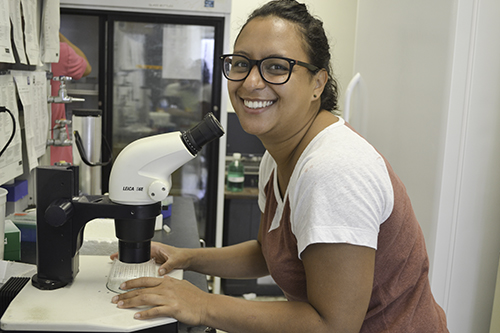
Molecular & Cellular Biology (MCB) PhD student Paola Estrada.
PhD students, as a general rule, have very little free time—most of their waking hours are spent holed up in some lab doing research. The precious little free time they do get, most choose to use it getting caught up on sleep or on food—or to socialize. Not Paola Estrada, however. This summer, the MCB PhD student took a break from her research to try to get 27 Urbana High School (UHS) students interested in science and engineering. Involved in MCB Day, the first day of I-STEM’s summer camp this past August, Estrada helped to expose the high schoolers to some of the basics of microbiology. Ironically, it involved forensics. The MCBees used a classic detective game of “Whodunit?” in which students used science to solve the "murder" of a grad student, and forensics is what brought Estrada to the US and set her on her journey as a researcher.
Born in the U.S., Paola Estrada grew up in Colombia, South America. She didn’t originally have her sights set on being a researcher in Biochemistry; her favorite subjects in school were actually history and economics! However, because she anticipated going into a criminal justice field, when the time came for her to attend college, she moved to New York to live with her aunt so she could go to school in the U.S.
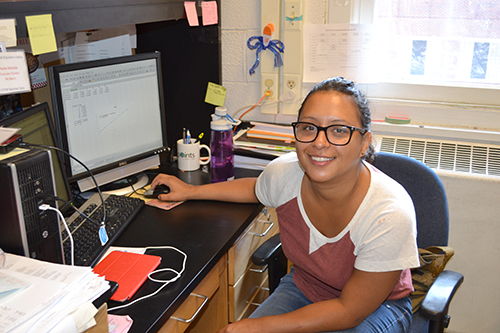
Paola Estrada at her desk in the Nair Laboratory.
Moving back to the States to undertake her education wasn’t problem free, though. One big challenge she had to overcome first involved the language barrier. Because moving to an entirely new country was already an enormous transition, Estrada felt that throwing in college classes taught in a different language would be too much of a strain. So she chose to take ESL classes for a year and a half at a local community college until she was able to speak English more fluently. However, due to New York’s large international population, she had few opportunities to practice outside of class. For instance, with her family and her community, she was able to get away with just speaking Spanish. Thus, Estrada eventually decided to jump straight into the deep end and enroll in college classes, where she’d be able to practice it full time.
So Estrada applied to and was accepted to the John Jay College of Criminal Justice CUNY, where she intended on majoring in criminalistics.
Estrada admits that overcoming the language barrier wasn’t easy and took several years. For example, she recalls that for the first two years, she didn’t socialize with anyone in her classes—not because, like most of the stereotypes about researchers, she was shy or anti-social—but because she quite literally couldn’t speak to anyone! However, Estrada eventually became comfortable enough with the language to even consider teaching science to other students, which is how she began her volunteer work.
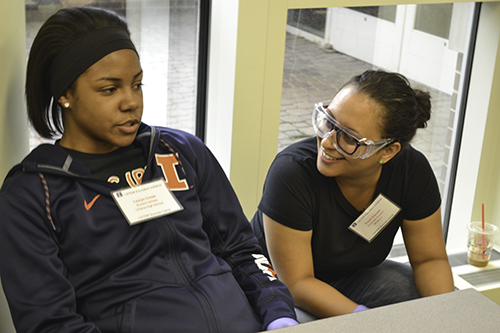
Above: Estrada speaks with Lauryn Cross, an Urbana High School student-athlete, during the I-STEM Camp's MCB Day.
 Below: Estrada at work in the lab.
Below: Estrada at work in the lab.
Once in college, intending a career in forensics, Estrada quickly figured out that she enjoyed the science behind forensics rather than forensics itself. “I didn't realize how much science it was going to be actually,” Estrada comments regarding her chosen major. “I thought it was going to be a little science, but mostly maybe a law type thing. Once I started doing it, turns out that it's a lot of science; it was all science pretty much.”
Something else she discovered? That she enjoyed getting her hands dirty in the lab much more than sitting in class learning all the theory. So in her junior year, Estrada began an undergraduate research program with an organic chemistry professor and soon discovered her niche; she quickly learned to love all that research had to offer.
Estrada is currently using protein crystallography to study proteins involved in the biosynthesis of natural products, possibly antibiotics. She and her fellow researchers at the Nair Laboratory hope to understand how these proteins make such complex compounds. She reports that "by understanding bacterial proteins we (the scientists of the world) could also start understanding some human proteins."
And her research is going well. For instance, Estrada is first author on a paper entitled “Structure and Function of the Pimeloyl-CoA Synthetase BioW Defines a New Fold for Adenylate-Forming Enzymes.”
In the future, Estrada definitely sees herself still in academia; her career goals involve higher education; she hopes to teach at a small inner-city college and also do research. “So far, I think I like teaching. I would like to stay in academia, but in a small, inner city school and not necessarily a big school like this one. I do want to continue research but probably maybe like mentoring undergrads to kind of push them into science,” Estrada explains.
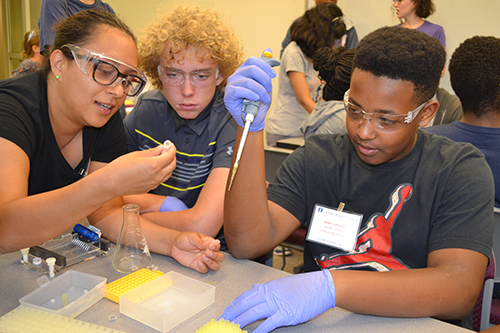
Above: Paola Estrada works with a UHS student using a pipette to get a DNA sample.
Below: Estrada presents to the I-STEM campers.
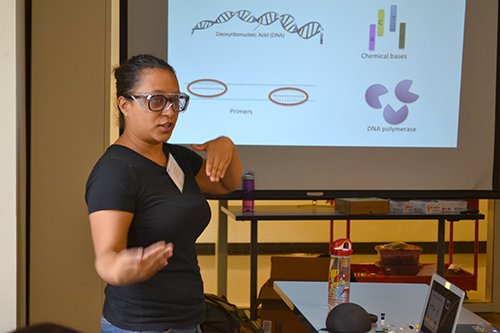
And getting to push kids into science was one reason why Estrada loved mentoring high schoolers at the I-STEM camp this year. When asked how the students did, Estrada replied, “I think they did really well. Even though some of them were trying to pretend they didn't care, you could see that they were a little impressed by some of the science things. They seemed really excited when they learned to pipette or when they were understanding this is actually stuff that scientists use in the real world and in real science.”
While the “Whodunit?” game might often be the closest that many people get to being a detective, the MCB graduate students took the 27 UHS students a step farther by teaching them all about the science behind many forensic procedures. And Paola Estrada, who was extremely excited to teach students about her field, is looking forward to seeing as many students in the sciences as possible because of the great experience she has had with it.
Story by: Nick O'Connell, I-STEM Undergradute Student Worker and a sophomore in Mechanical Science and Engineering
Photographs by: Elizabeth Innes, Communications Specialist, I-STEM Education Initiative
For more related stories, see: MCB, MCBees, Student Spotlight, Underserved Students/Minorities in STEM, Women in STEM, 2017
For additional I-STEM articles about MCBees and the work they've done previously, see:
- MCBees Use “Whodunit?” to Pique UHS Students’ Interest in Science During I-STEM Summer Camp
- MCBees Help Provide Student Support, Recruit, & Share the Joy of Science
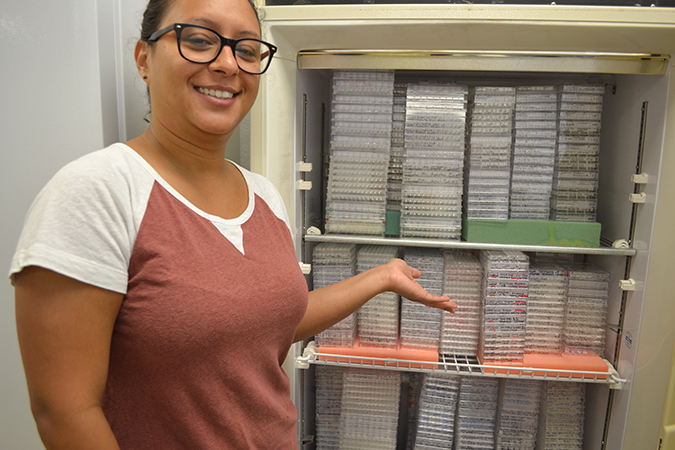
Paola Estrada presents a stockpile containing all her past completed work.













.jpg)
















